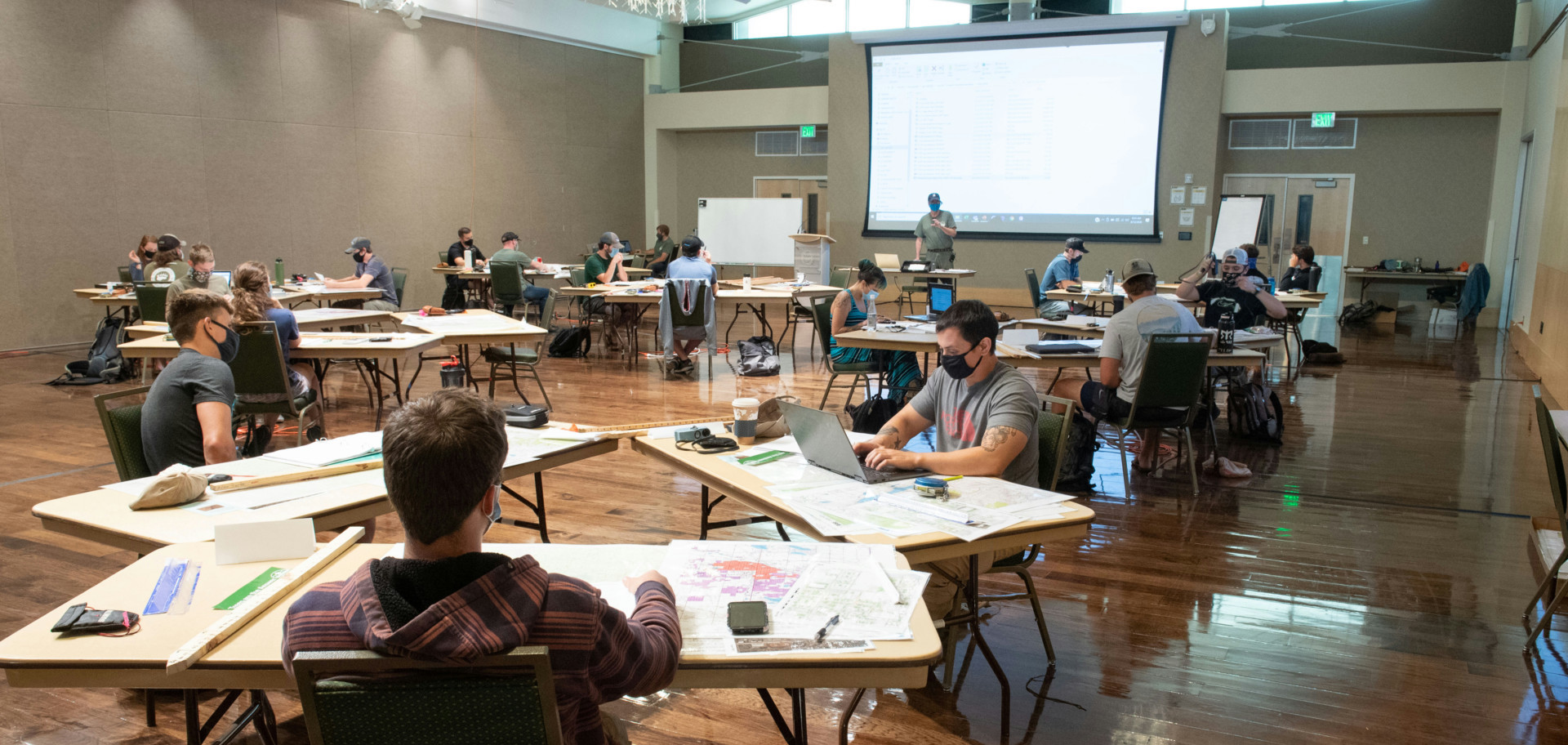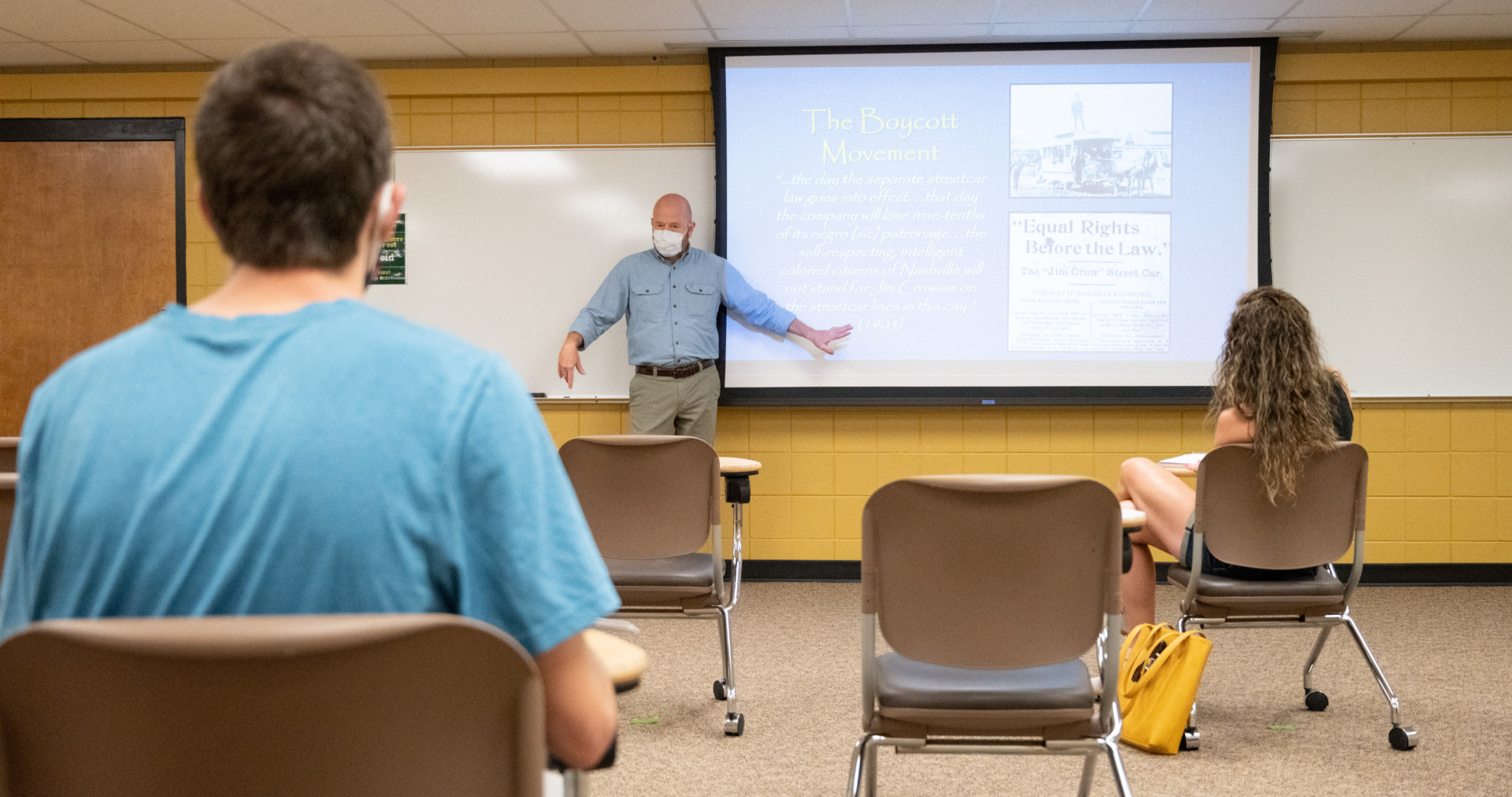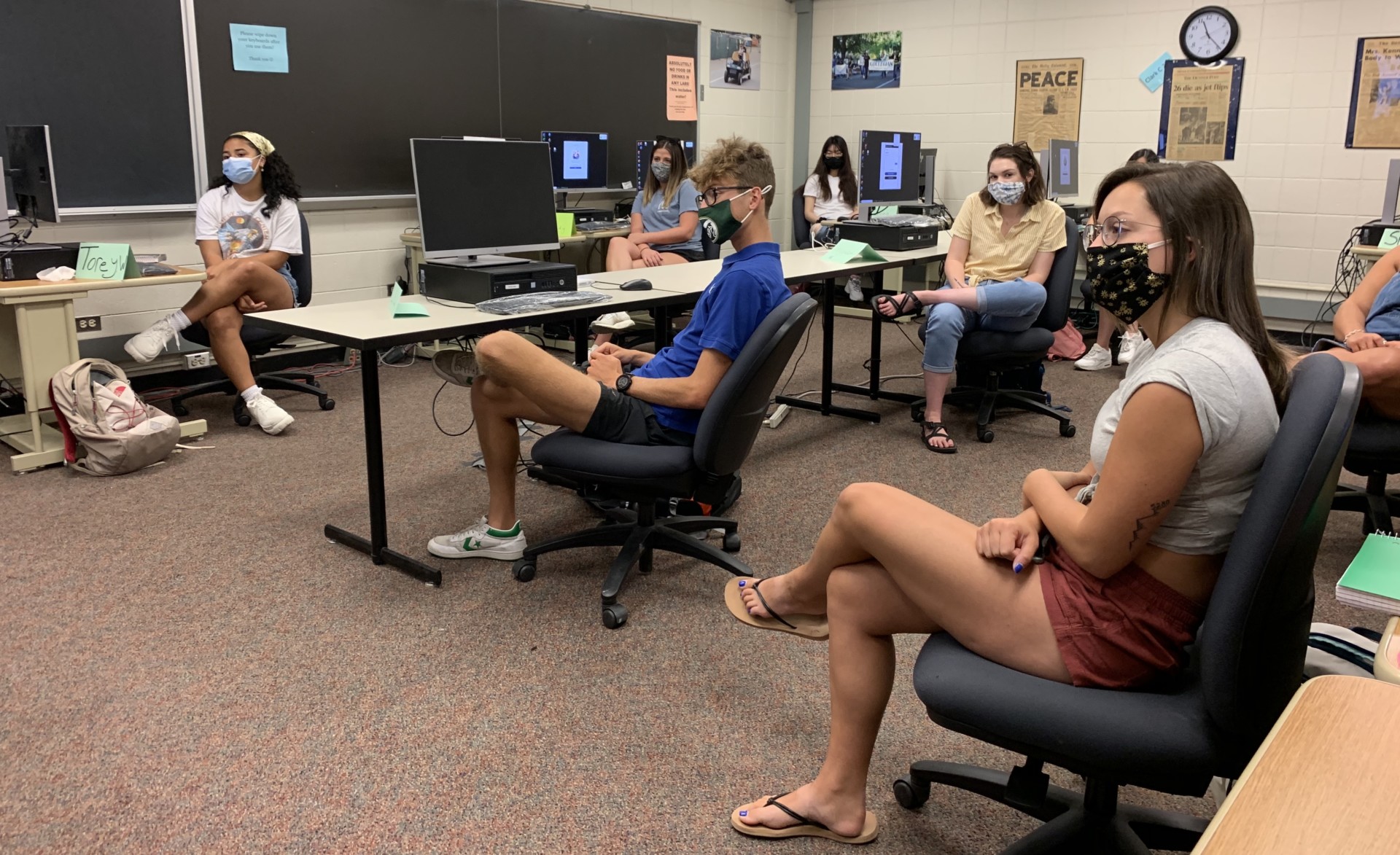
Ben Randall, center, a journalism and media communication major, in class the week of Aug. 24. Seats are blocked off to ensure proper social distancing.
Photo by Greg Luft
When the fall semester got underway at Colorado State University on Aug. 24, about 64% of classes were taught either entirely face-to-face or in a hybrid model with some in-person instruction.
Considering the new health protocols prompted by the COVID-19 pandemic, members of the university community say that it took a lot of collaboration and hard work by many people behind the scenes to have so many courses with an in-person element.
“In early April, the challenges seemed monumental,” said Kelly Long, vice provost for undergraduate affairs. “Yet collaboration with many units on campus made accomplishing an ambitious goal possible.”
It also made Kristi Buffington, the space information and data manager for Facilities Management, thankful that she has an interior designer on staff. Terry Adams, and her colleague Mike Shortall, faced the daunting task of mapping out general assignment classrooms on campus and redesigning their layout to create 6 feet of space between each student.
“That was very time-consuming and a lot of effort,” Buffington said. “It took us most of the summer.”
Once the team determined the new room configurations and capacities, it was a bit of a shock.
“Capacities went way down,” Buffington said. “Everyone was surprised because it was a big drop.”
Students are introduced to campus health protocols in this video by Journalism and Media Communication department head Greg Luft, with footage from Ryan Crist and Brian Buss. Narrated by Sarah Pooler. Masks made and demonstrated by Clara Scholz.
Shuffling pieces
Lise Youngblade, dean of the College of Health and Human Sciences, said one major initial issue in adhering to those new room capacities was that most CSU students, with the notable exception of first-year students, had already registered for their courses and created their schedules, so staff in the Registrar’s Office had to figure out how to deal with classrooms that could now only accommodate half — or fewer — of the students they normally would.
“Most of the course schedules were already set, so we couldn’t easily move things, especially into new times,” Youngblade explained. “That’s where the magic of the Registrar’s Office came in. It was a constant moving target to keep the students who were enrolled in courses intact, the time of the courses intact, but be creative with our spaces.”
Long highlighted the efforts of Julia Murphy and D. Tobiassen Baitinger in the Registrar’s Office in particular.
“Without them, none of this would have been possible,” Long said. “We have been meeting with them nearly every day since April.”
Among other moves, additional course sections were added in the late afternoon or evening, Lory Student Center ballrooms were turned into classrooms, and courses with more than 99 students were converted to online-only, but Long said it’s amazing that about two-thirds of CSU classes still have a face-to-face component.
“We are pleased to have landed with such a high percentage of on-campus and hybrid courses,” she said. “And we have taken every step we could this summer to keep this campus healthy.”

Students attend Rocky Coleman’s “Forestry Field Measurements” course in one of the Lory Student Center’s ballrooms on Aug. 12. Photo by John Eisele
Course adjustments
With the changes made by Facilities Management and the Registrar’s Office in place, faculty then had to decide how to adjust their courses to incorporate remote learning as needed — but also preserve as much face-to-face contact as they could. Ben Withers, dean of the College of Liberal Arts, praised the faculty who worked tirelessly over the summer to get ready for teaching this fall.
“Thanks to efforts from The Institute for Learning and Teaching and CSU Online, there were over 1,300 enrollments in workshops and short courses designed to assist faculty preparing for the challenges they would face this fall,” he said.
In addition, many faculty revamped and rethought their approaches on their own to make the coursework changes necessitated by the mix of traditional in-person and hybrid instruction. Withers noted that this was in addition to learning new health protocols and how to use new technology installed in their classrooms.
Withers — along with Youngblade, Associate Provost Steve Dandaneau, College of Natural Sciences Dean Jan Nerger, and Graduate School Dean Mary Stromberger — served on the Teaching and Learning Continuity and Recovery Task Force chaired by Long. Non-academic leaders such as Buffington were also members of that group.
“We need to take great pride in the hard work done over the summer,” Withers said. “We realize we’re not out of it yet, and we may need to pivot. But there was a lot of effort and thought that went into how this fall would look. It’s quite a testament to people’s commitment to the students here.”
Video by Ron Bend
Quality of online teaching
“We are talking about incredible efforts by our faculty to enhance and expand their teaching,” Youngblade said, adding that while some question the quality of online learning versus in-person learning, it can sometimes be more effective during this time. Youngblade noted that student engagement in an online discussion board can be higher than in an in-person discussion with everyone wearing face coverings, in a sparsely populated, socially distanced room.
“There is nothing subpar about online teaching that uses intentional approaches to maximize learning,” she said. “The amount of effort that faculty have put in to learn new technologies and make their courses flexible, accessible and high-quality has been above and beyond. The bottom line is we learn from both types of teaching. I actually think this is going to be one of our finest semesters for teaching because of the efforts of our faculty in responding to this challenge, and their commitment to expanding their teaching toolbox and refining their use of different modalities.”
Stromberger acknowledged the efforts of Vice President for Information Technology Brandon Bernier and his team for significantly increasing the number of classrooms equipped with lecture-capture technology, which allows many more classes to have an in-person element instead of being delivered completely online. Others lauded Bernier, TILT Executive Director Gwen Gorzelsky, and Chris LaBelle, interim senior director of CSU Online, for providing support for the Canvas learning platform, professional development for faculty, and online teaching guidance. Nerger noted that Linda Meserve of Procurement Services and Steve Burn of Central Receiving worked long hours to move and store extra furniture; locate, order and maintain personal protective equipment; and set up the sanitization stations.

History Instructor Mike Mansfield teaches a class in the Clark Building on July 15. Photo by John Eisele
A student perspective
Ben Randall, a junior from Omaha, Nebraska, who is majoring in journalism and media communication, said he has four instructors employing hybrid models that incorporate in-person learning, and each has taken a slightly different approach. He said he’s learning just as much as he would in a traditional classroom setting because of the faculty’s energy.
“It’s remarkable — these teachers don’t seem to be fazed,” Randall said. “It’s almost like they’ve gone through a pandemic before. They are so passionate and dedicated; it’s really inspiring. It makes me thankful for the faculty and the university’s commitment to learning.”
Randall added that while some instructors have jokingly asked how many weeks it will be before CSU has to go back to remote learning, he is optimistic that students will act responsibly when it comes to health. He said most students are wearing face coverings while on campus, even when they are outdoors.
“I, for one, am very hopeful that we can do this; we just need to abide by the rules,” Randall said. “It really makes one proud, seeing all the work the university did to get ready. We’ll be ashamed if we get sent home, because it’s entirely on us.”

Randall, center, in a newly configured classroom in the Clark Building. Photo by Greg Luft
Heavy lifting by Facilities Management
Once Buffington’s team determined the new capacities and configurations of classrooms, Facilities Management staff took on tasks like moving and removing chairs and desks, taping off and marking surfaces and seats that shouldn’t be used, and rearranging furniture.
Tom Satterly, associate vice president for Facilities Management, said every group in his department contributed to the effort, from the custodial/operations team ramping up cleaning and disinfection to the engineering and trade shops’ efforts to improve building ventilation, increase filtration and boost the rate at which air is exchanged through buildings. In addition to Buffington’s team, he praised the building code compliance group and the remodel/construction teams that had to implement the changes to room configurations. Satterly said the last few weeks leading up to the start of the semester were extremely busy, but his staff responded remarkably well.
“We had to sprint these last couple of weeks,” he said. “But we’re a can-do kind of organization. It’s a 600-person team, they are facilities professionals, and that’s why a lot of this got done. People step up and do the right thing. We just rose to the challenge, like we always do.”
“More than ever, I recognize the role of facilities staff and other campus units in providing a team approach to the success of this campus,” Long said. “We’ve all formed deep respect and gained better awareness of the interrelatedness of our efforts.”
“It was great to see so many different groups of people come together and make this happen,” Withers added. “No one group could have done it. Without the help of so many, we would not be anywhere close to where we are now.”
“There’s no one that hasn’t had a handprint on this process,” Youngblade said. “It’s truly been a campus-wide effort, and the health of our community was right there in the center, as our top priority.”